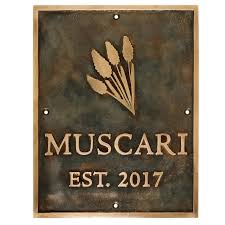Unveiling the History of Brass Plaques: How They Emerged in the Market
Introduction
Brass plaques have a long-standing tradition as elegant and enduring forms of commemoration. These distinctive metal plates, crafted from a combination of copper and zinc, have adorned buildings, memorials, and personal possessions for centuries. In this article, we delve into the fascinating history of brass plaques, exploring their origins, evolution, and how they emerged in the market as cherished symbols of remembrance and recognition.
Ancient Origins
The use of metal plaques for commemorative purposes can be traced back to ancient civilizations. The Egyptians and Romans, known for their exceptional metalworking skills, created bronze and brass plaques to honor notable individuals and important events. These early examples showcased intricate engravings, depicting narratives and achievements.
Medieval Era and Renaissance
During the medieval era, brass plaques gained prominence in Europe. Churches, monasteries, and royal households commissioned elaborate plaques to immortalize the memory of loved ones or to mark significant historical events. The art of brass engraving flourished, and craftsmen skillfully etched intricate details onto the plaques. These works often featured religious motifs, coats of arms, and epitaphs.
Industrial Revolution and Mass Production
The Industrial Revolution in the 18th and 19th centuries revolutionized the production of brass plaques. The advent of mechanized manufacturing techniques and advancements in metalworking machinery enabled the mass production of these plaques. This shift made brass plaques more affordable and accessible to a wider audience. As a result, the market for brass plaques expanded considerably, finding its way into various public and private spaces.
Public Monuments and Memorials
Brass plaques became popular additions to public monuments and memorials during the 19th and early 20th centuries. Architects and designers embraced these plaques to commemorate fallen soldiers, historical events, and noteworthy figures. The enduring nature of brass made it an ideal material for outdoor applications, as it withstood the elements while maintaining its visual appeal. From war memorials to historical landmarks, brass plaques served as tangible reminders of the past, connecting communities with their heritage.
Personalized Use and Commemoration
Alongside public installations, brass plaques found their way into private spaces, becoming cherished mementos for individuals and families. People began to use brass plaques to honor loved ones, commemorate milestones, and signify personal achievements. These custom-made plaques allowed individuals to express their sentiments and preserve memories in a tangible and lasting form. From memorial plaques to house signs and trophy plates, brass became synonymous with elegance and prestige.
Contemporary Applications
Today, brass plaques continue to thrive as versatile and enduring symbols. Their timeless appeal and durability make them suitable for a wide range of applications. From corporate plaques to architectural signage, the market for brass plaques has evolved to cater to diverse needs. Modern manufacturing techniques, including laser engraving and etching, have further expanded design possibilities, allowing for intricate details and personalization.
Conclusion
The history of brass plaques is a testament to their enduring significance as markers of remembrance and recognition. From their ancient origins to contemporary applications, brass plaques have evolved and adapted to the changing times while preserving their timeless elegance. Whether adorning historical landmarks or memorializing personal achievements, these metal plates continue to hold a special place in our collective memory, adding a touch of sophistication and permanence to our surroundings.
Featured Products
- From $192.00
$480.00- From $192.00
- Unit price
- / per
-
Bronze
- From $140.00
$350.00- From $140.00
- Unit price
- / per
-
Bronze
- From $120.00
$300.00- From $120.00
- Unit price
- / per
- From $96.00
$240.00- From $96.00
- Unit price
- / per
- From $96.00
$240.00- From $96.00
- Unit price
- / per
- From $192.00
$480.00- From $192.00
- Unit price
- / per
-
Silver
-
Black
- From $96.00
$240.00- From $96.00
- Unit price
- / per
- From $120.00
$300.00- From $120.00
- Unit price
- / per
-
Black
- From $96.00
$270.00- From $96.00
- Unit price
- / per
- From $96.00
$270.00- From $96.00
- Unit price
- / per
- From $108.00
$270.00- From $108.00
- Unit price
- / per
- From $144.00
$480.00- From $144.00
- Unit price
- / per
- From $192.00
$480.00- From $192.00
- Unit price
- / per
-
Brass
- From $96.00
$240.00- From $96.00
- Unit price
- / per
- From $96.00
$240.00- From $96.00
- Unit price
- / per
-
Brass
- From $140.00
$350.00- From $140.00
- Unit price
- / per
-
Brass
-
Silver
- From $96.00
$240.00- From $96.00
- Unit price
- / per
- From $96.00
$240.00- From $96.00
- Unit price
- / per
-
Antique
- From $96.00
$240.00- From $96.00
- Unit price
- / per
-
Antique
- From $96.00
$240.00- From $96.00
- Unit price
- / per
-
Antique
-
Brass
Sample Image Gallery
- 3d brass plaque
- address plate
- brass door sign
- brass plaques
- brass sign marker
- brass signage
- brass tags
- cast brass plaques
- comemorative plaque
- custom brass plaque
- designer plaque
- door plaque
- door plate
- door sign
- engraved plaque
- etched plaque
- grave marker plaque
- historical plaque
- hotel plaques
- house plaque
- ladies gents plaque
- memorial plaque
- number plaque
- open closed plaque
- outdoor plaque
- oval plaque
- plaque stand
- plaques
- restoroom plaque
- signage















































